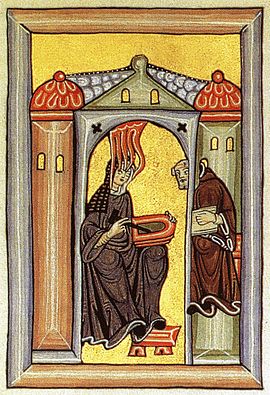
What a relief! Here is a Saint who was not flayed alive, burnt on a griddle, scratched with wool combs, crucified upside down, beheaded, eyes gouged out, etc. etc. (consider identifying the Saints in this list as my Christmas Quiz). She died of illness, aged 81 and was famous not just for her vision but her erudition, her scientific writings, and hermusical compositions. She came from the Rhineland area of Germany.
Before you proceed to read this post listen to this YouTube clip of her sublime music.
Hildegard of Bingen: De Spiritu Sancto (Holy Spirit, The Quickener Of Life)
She was elected as magistra (Mother Superior) of her Convent in 1136, and went on to found two other nunneries. But, was made famous by her writings on her visions. She was also a famous composer of sacred monophony,
There has been speculation that her visions were caused by migraine. Read Mary Sharratt’s piece for more details, from which I took the following quotation.
‘When I was forty-two years and seven months old, Heaven was opened and a fiery light of exceeding brilliance came and permeated my whole brain, and inflamed my whole heart and my whole breast, not like a burning but like a warming flame, as the sun warms anything its rays touch.‘
Hildegard von Bingen, Scivias, translated by Mother Columba Hart, O.S.B., and Jane Bishop
Among the many books she wrote were two famous and early books on medicine and science. Her medical writing was highly practical although, of course, based on the humoural theories which had held sway since Hippocrates. However, she did think that the four humours had a hierarchy with blood and phlegm the more superior humours representing the celestial elements of fire and air, while black bile and yellow bile represented the earthly humours of earth and water.
Just as physicists today look to find a unifying theory of everything, Hildegard also tried to find unities within the body of classical knowledge. According to Wikipedia, she:
‘often focuses on interrelated patterns of four: “the four elements (fire, air, water, and earth), the four seasons, the four humours, the four zones of the earth, and the four major winds.” ‘
Linked also to the celestial bodies and to religion, she gave her world view in Causae et Curae c. 42:
It happens that certain men suffer diverse illnesses. This comes from the phlegm which is superabundant within them. For if man had remained in paradise, he would not have had the flegmata within his body, from which many evils proceed, but his flesh would have been whole and without dark humour [livor]. However, because he consented to evil and relinquished good, he was made into a likeness of the earth, which produces good and useful herbs, as well as bad and useless ones, and which has in itself both good and evil moistures. From tasting evil, the blood of the sons of Adam was turned into the poison of semen, out of which the sons of man are begotten. And therefore their flesh is ulcerated and permeable [to disease]. These sores and openings create a certain storm and smoky moisture in men, from which the flegmata arise and coagulate, which then introduce diverse infirmities to the human body. All this arose from the first evil, which man began at the start, because if Adam had remained in paradise, he would have had the sweetest health, and the best dwelling-place, just as the strongest balsam emits the best odour; but on the contrary, man now has within himself poison and phlegm and diverse illnesses.
Wikipedia:
And here I was hoping to find light and joy in a medieval Saint’s story! So we seem to be doomed by Adam’s Fall, and the poor quality of his semen. (Having recently watched Hugo Blick’s Wild West box set ‘The English’, I can quite understand the syphilitic underpinnings of Hildegard’s theory).
On the subject of headaches, Hildegard was a keen user of feverfew, which has been, since the 18th Century, a suggested cure for Migraine. I didn’t find it worked for me, being a sufferer since age 12. It never occurred to me to think that the flashing lights, partial temporary blindness, tingling muscles and devastating headaches might be a gift from God.
Hildegard wrote the following about feverfew:
“If you suffer from a sick intestine, boil the Motherswort with water and butter or oil and add some spelt flour. Prepare a drink, for it helps the intestines.”
Hildegard of Bingen, Physica, Cap. 116 quoted in Hildegard’s Feverfew Use (www.healthyhildegard.com/feverfew-uses)
And so it became popular among women for gynaecological issues and abdominal pain. Feverfew has flowers like a daisy, ‘growing in every hedgerow’ according to Mrs Grieve’s English Herbal. Grieve’s says it is good for nervous and hysterical complaints; low-spirits; as a syrup good for coughs; as a tincture against swellings caused by bites of insects and vermin.

St Hildegard seems to have two special days – one is Dec 17th and the other is the day she died, September 17th 1179 which is her ‘Liturgical Feast’.
First Published on December 18th, 2022, Revised and republished December 2023, 2024
